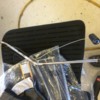quote:
Why do you feel it needs to be sealed?
Not an emissions issue on our cars. Tank came with one vent.
I can see nothing wrong with two vents?
Larry, the way the Tank/Filler Neck is constructed on the Pantera does that Fuel can find its way up to the Cap under driving when the Tank is full or close. And I just don't want it to overflow and run down the overflow pipe and on to the Tarmac. I believe that is why they designed it to be vented via the blue Tank on the RH side of the Engine Bay and not via the Fuel Cap?
quote:
I did my restoration going on 10 years ago now, so my memory is a bit fuzzy on this. But I seem to remember being able to adjust when the sending unit sent the signal to the low fuel light. There are 2 rheostats in the sending unit. One for the gage and the other for the light. By carefuly bending the tab for the light, you can adjust when it comes on. Mine comes on at about 1/8th of a tank now. Can anybody clear up my fuzziness? And I also apologise if I hijack this thread!
I recently pulled the Fuel sending unit to modify it with a larger diameter tube. Went from 5/16" to 1/2" Pipe to secure no restrictions to feed the new RobBMC Fuel Pump. My point is sorry, there are not 2 Rheostats in the sender, there is one and then there is a set of Contacts for the low-fuel Light. And as correctly mentioned it is very easy to adjust the position for when the Contacts close and illuminate the caution lamp on the gauge. I have about 50Km left when light is steady on.





